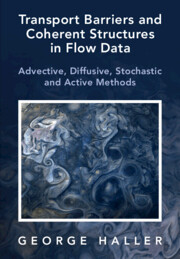 Transport Barriers and Coherent Structures in Flow Data
Transport Barriers and Coherent Structures in Flow Data Book contents
- Frontmatter
- Dedication
- Contents
- Preface
- Acknowledgments
- 1 Introduction
- 2 Eulerian and Lagrangian Fundamentals
- 3 Objectivity of Transport Barriers
- 4 Barriers to Chaotic Advection
- 5 Lagrangian and Objective Eulerian Coherent Structures
- 6 Flow Separation and Attachment Surfaces as Transport Barriers
- 7 Inertial LCSs: Transport Barriers in Finite-Size Particle Motion
- 8 Passive Barriers to Diffusive and Stochastic Transport
- 9 Dynamically Active Barriers to Transport
- Appendix
- References
- Index
6 - Flow Separation and Attachment Surfaces as Transport Barriers
Published online by Cambridge University Press: 20 February 2023
- Frontmatter
- Dedication
- Contents
- Preface
- Acknowledgments
- 1 Introduction
- 2 Eulerian and Lagrangian Fundamentals
- 3 Objectivity of Transport Barriers
- 4 Barriers to Chaotic Advection
- 5 Lagrangian and Objective Eulerian Coherent Structures
- 6 Flow Separation and Attachment Surfaces as Transport Barriers
- 7 Inertial LCSs: Transport Barriers in Finite-Size Particle Motion
- 8 Passive Barriers to Diffusive and Stochastic Transport
- 9 Dynamically Active Barriers to Transport
- Appendix
- References
- Index
Summary
Flow separation is the ejection of fluid particles from a small neighborhood of a solid boundary. Such a breakaway from the boundary is often due to the detachment of a boundary layer, but it also occurs in highly viscous flows where the boundary layer description is inapplicable. Accordingly, we will treat separation here as a purely kinematic phenomenon: the formation of a material spike from a flow boundary.Such material spikes form along attracting LCSs, as we have already seen inthe previous chapter. We consider LCSs acting as separation or attachment profiles here separately because their contact points with the boundary and their local shapes near the boundary can be located from a purely Eulerian analysis along the boundary. Since the attachment points of material separation profiles cannot move under no-slip boundary conditions, such profiles necessarily create fixed separation. In contrast, material spikes emanating from off-boundary points generally result in moving separation in unsteady flows. We will discuss how both fixed and moving separation can be described via material barriers to transport.
Keywords
- Type
- Chapter
- Information
- Transport Barriers and Coherent Structures in Flow DataAdvective, Diffusive, Stochastic and Active Methods, pp. 242 - 274Publisher: Cambridge University PressPrint publication year: 2023
